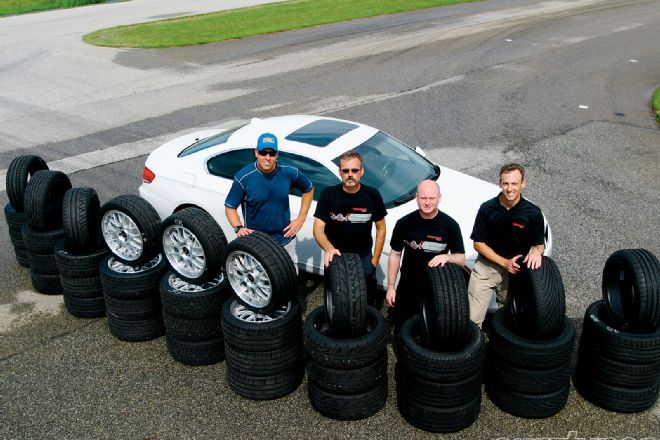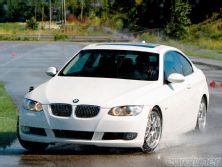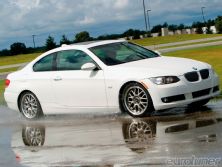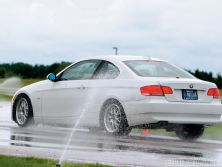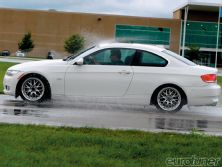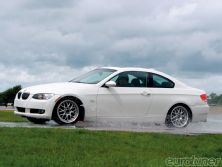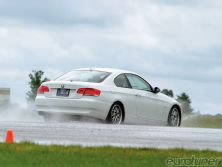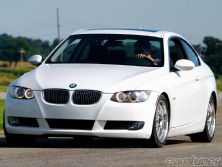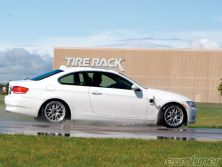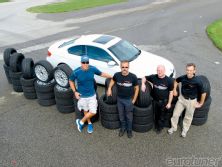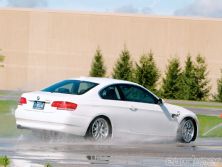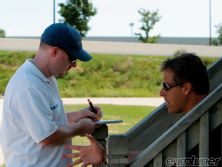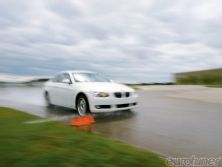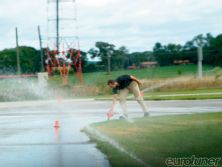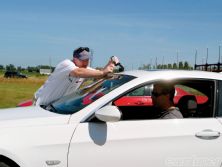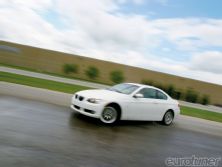We've all heard thousands of times how your car tires are the single most important purchase you can make. They're the only contact between you and the road, and their ability to grip has far-reaching consequences.
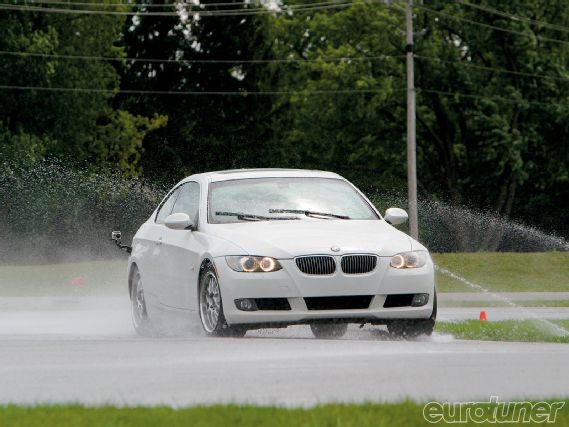 |
High-Performance Tires Buying Guide - Get A Grip!
|
High-Performance Tires Buying Guide - Get A Grip!
The problem is, we hear it so often we tend to switch off. It's become a cliché, yet its message remains true. Not only can they save your life by reducing braking distances, they can knock seconds of your lap times - which is something you'd spend $$$-thousands to achieve with engine tuning alone.
We all know this, and many of us go through a rigorous selection process when buying new tires. We consider performance, cost, reputation, marketing, even appearance. The problem is, a wrong decision can be catastrophic. What's more, it can undermine months or years of hard work.
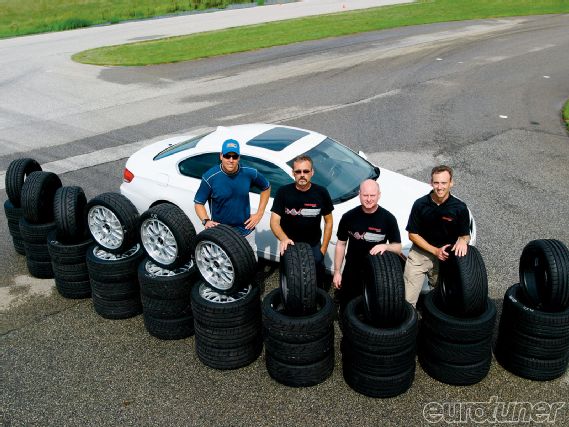 |
High-Performance Tires Buying Guide - Get A Grip!
|
High-Performance Tires Buying Guide - Get A Grip!
Take a look at Readers' Rides in several issues. There's always somebody who spent a fortune on suspension upgrades, but wimped out when purchasing rubber. A no-name, budget brand might appear to save you money, but you'll definitely regret it in the wet, and probably in the dry as well.
So how can we be better informed? We've put together our third, independent eurotuner tire test to help you find which tires perform best in various conditions. However, the problem with this kind of test is making it repeatable and consistent. You need to control the environment, so we again used the facilities at Tire Rack's HQ in glorious South Bend, IN.
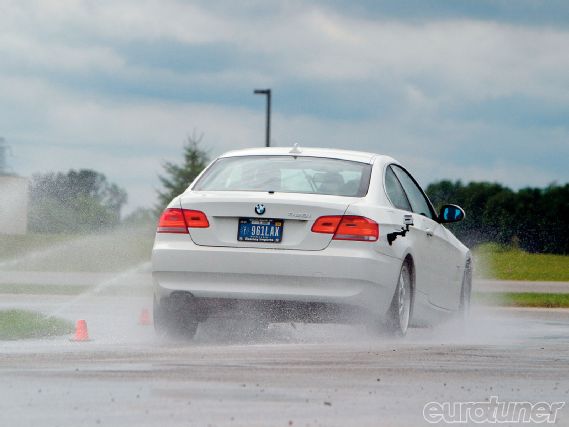 |
High-Performance Tires Buying Guide - Get A Grip!
|
High-Performance Tires Buying Guide - Get A Grip!
Conveniently, the retailer has its own test track to scrutinize every product before selling it to customers. If you visit www.tirerack.com you'll not only find great deals on tires, wheels, brakes, suspension, etc but the tires are regularly tested to let you make an informed purchase.
Most of their tests are done in small groups, but we wanted to collect a larger selection of tires applicable to the tuner market. So eurotuner's test is completely independent of Tire Rack's own findings and may produce slightly different results than they achieve with their own drivers. We also brought several brands not distributed by Tire Rack.
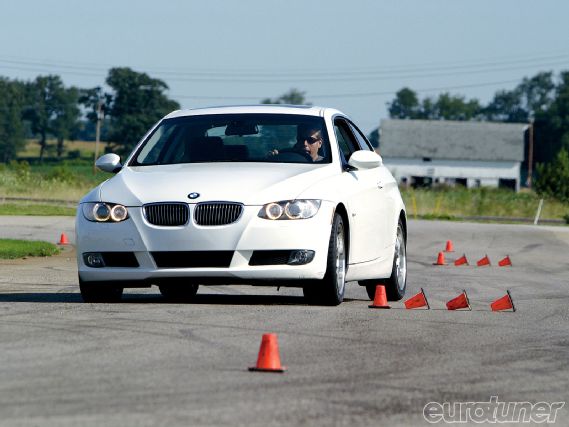 |
High-Performance Tires Buying Guide - Get A Grip!
|
High-Performance Tires Buying Guide - Get A Grip!
In order to assess the tires, we'd measure overall lap times, slalom times (for direction changes), g-force (for outright grip) and braking. What's more, we could do it in the wet and dry thanks to Tire Rack's sprinkler system and sophisticated timing.
Equipped with a fleet of BMW 328i, all we needed was the tires and a driver. Most tires were removed from Tire Rack's enormous warehouse, eliminating the chance of "ringer" tires being provided by the manufacturers. We then sourced the few brands not available here from independent dealers.
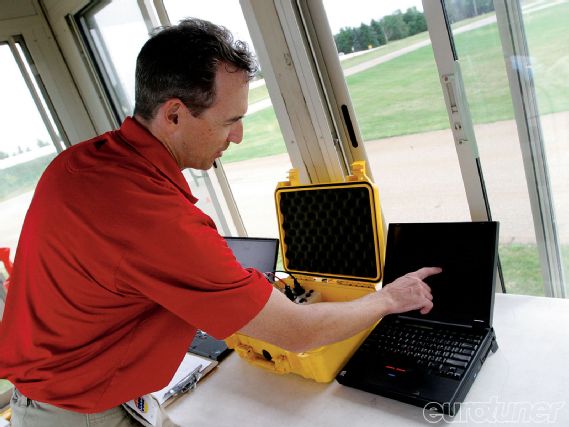 |
High-Performance Tires Buying Guide - Get A Grip!
|
High-Performance Tires Buying Guide - Get A Grip!
Since we were using BMWs, who better to employ for driving duties than Will Turner from Turner Motorsport? Besides being a friend and running a successful BMW tuning business, he helped with our previous tests in 2004 and '05, drives the TMS 330i in the Grand-Am Cup racing series and runs a pair of E46 M3s in the same series (www.turnermotorsport.com). Having tuned, tested and won in BMWs, few people were more qualified to drive for us.
Please don't turn the page if you own a VW, Audi, Mini, etc because the results apply equally to your car. We used BMWs simply because Tire Rack makes them available to us, having decided they were sufficiently rugged to tolerate constant abuse, and the rear-drive chassis is nimble enough to provide consistent results. The BMWs have the Steptronic transmission for consistency, and the traction control was switched off.
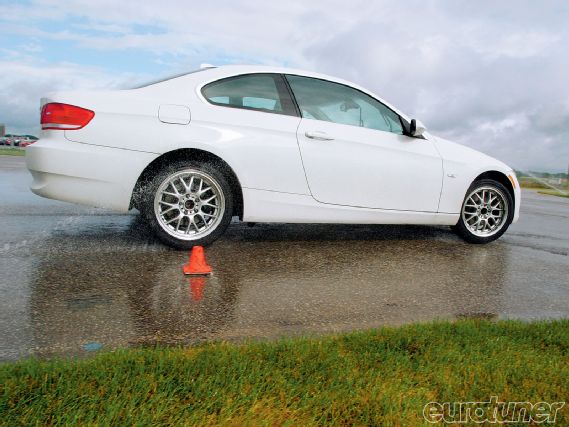 |
High-Performance Tires Buying Guide - Get A Grip!
|
High-Performance Tires Buying Guide - Get A Grip!
The Test We made almost no changes from the test procedure used in 2004 and '05 because it worked so well. Consequently, when our driver first arrived at the track, he was put behind the wheel of a 328i on control tires. These were 225/45 R17s on 17x8" ASA AR1 wheels (21.2 lb).
In the dry, Tire Rack selected Continental ContiSportContact 3 control tires, switching to a Yokohama Advan Sport in the wet. Both were considered consistent performers that would provide a benchmark. Furthermore, the control tires would appear at fixed intervals throughout the day to gauge how well the driver was "learning" the track or whether the conditions were changing. Any variation in "control" lap times would be factored into the test results to compensate for changing conditions.
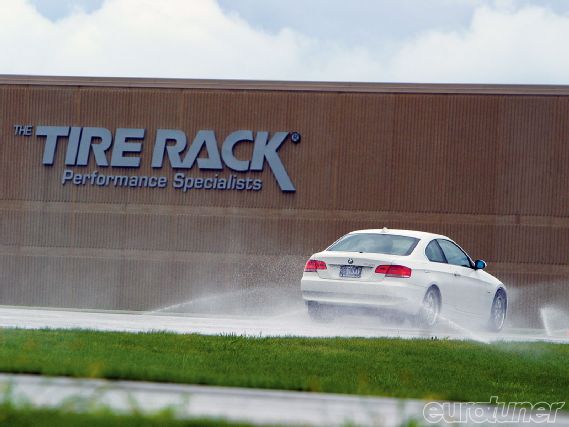 |
High-Performance Tires Buying Guide - Get A Grip!
|
High-Performance Tires Buying Guide - Get A Grip!
All 10 sets of test tires were fitted to the 48 identical ASA wheels Tire Rack keeps for such occasions. The tires were inflated to 35psi all round. While 32 front, 35 rear is more conventional, Tire Rack's John "Woody" Rogers has found this increases tire wear, resulting in understeer, which in turn masks the subtle differences between tires. Therefore, they run at 35psi for a good balance.
Our driver completed four timed laps on each set of tires in both the wet and dry. Rejecting the fastest and slowest laps, the score is the average of the two. Dry-weather testing took place on the first day, wet on the second (because rain was forecast). Brake testing was conducted by Tire Rack because they have the experience to be consistent, conducting ten stops from 50mph and again taking an average.
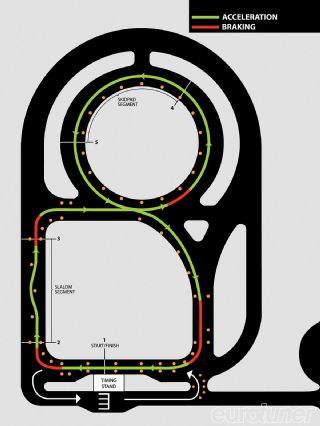 |
High-Performance Tires Buying Guide - Get A Grip!
|
High-Performance Tires Buying Guide - Get A Grip!
What was again amazing to us was the analytical powers of our driver. Despite driving on 11 different tires (including the controls) each day, Will was able to estimate lap times and rank the tires against its peers. He was also remarkably consistent, finding the limit of adhesion and completing the flying laps within a few tenths of a second of each other, particularly in the wet.
We asked for Will's comments on each tire as he stepped from the car. What you'll see from the comments over the page is that most tires performed to a similarly high level. In previous tests, several brands stood out, but this batch seemed to be closer in performance.
In general, Will's comments and times concurred with Tire Rack's own research on the products they'd tested, which indicated we were on the right track. What was interesting was to see how brands not stocked or previously tested compared.
 |
High-Performance Tires Buying Guide - Get A Grip!
|
High-Performance Tires Buying Guide - Get A Grip!
Of course, Will never knew what tires were on the car. This was to avoid any chance of bias. People can drive differently if they have expectations about a tire, perhaps driving harder if they know the tire has performed well in the past, or vice versa.
The Tire Rack Track
The track has several combinations, but we used a figure-eight layout for its combination of 90° bends leading to a 200ft skidpan circle. Cones were used to provide a lane-change exercise, in addition to tightening some corners. This combination provided a variety of handling situations, as well as braking tests and g-force assessment. The track is ringed with laser beams that time the overall lap, time through the lane change, as well as the skidpan (from which g-force can be calculated). The track is a relatively simple layout, which helps drivers achieve consistency.
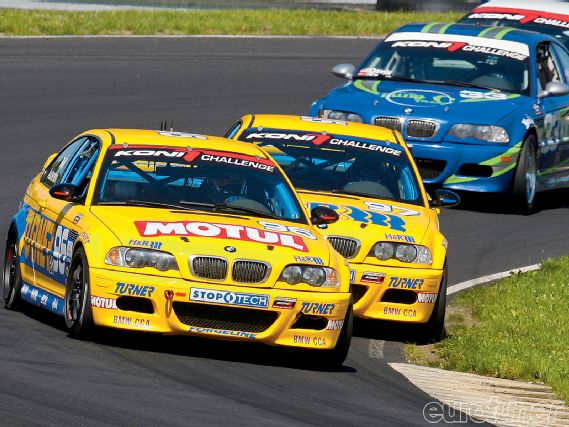 |
High-Performance Tires Buying Guide - Get A Grip!
|
High-Performance Tires Buying Guide - Get A Grip!
The surface is smooth but is starting to show signs of wear from the constant, daily use. So the cones have been moved slightly to avoid the heaviest wear.
A series of sprinklers allow the track to be doused with water, simulating rainfall. The surface is cambered 1° to the inside, like most public roads. The idea is to recreate the sort of driving conditions you might encounter every day.
The Tire Rack
The Tire Rack prides itself on being a well-stocked company with informed employees and, from what we saw during our testing at Tire Rack's South Bend headquarters, we can't dispute its claims. For starters, Tire Rack has a track where it tests all the products it sells. That means it doesn't take a manufacturer's claimed performance as fact. If a tire, wheel or suspension package performs, Tire Rack employees know because they tested it personally.
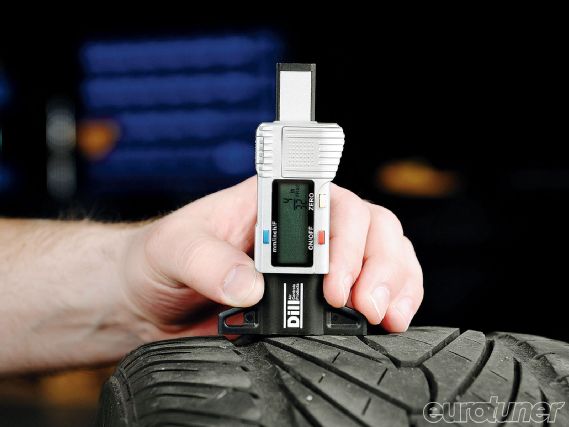 |
High-Performance Tires Buying Guide - Get A Grip!
|
High-Performance Tires Buying Guide - Get A Grip!
Every team member spends roughly 80 hours a year in the classroom and testing products. Therefore, when you call to order something, the person taking your order is educated on correct fitments and knows how the product could affect your car.
As for stock, Tire Rack has six giant warehouses across America - in South Bend, IN, New Castle, DE, Windsor, CT, Midway, GA, Shreveport, LA and McCarran, NV - all stocking more products than you can imagine. In fact, some tire manufacturers use these warehouses as an emergency reserve. For the customer, this means the tire you want is a phone call away. Check out the website and see for yourselves exactly what they offer, and view the forums to see what their customers have to say about each product (www.tirerack.com)
Turner Motorsport
Will Turner, owner of Turner Motorsport, founded the company in 1993 as a way to fund his hobby for BMW tuning and racing. It's since grown into one of the premiere BMW performance tuners and the most successful BMW touring car teams in the US.
They have a 25000sqft facility located in Amesbury, MA that includes a showroom, warehouse, mail-order dept and a 6500sqft workshop for installation, fabrication and R&D. Their experienced technicians work on high-performance upgrades for street cars alongside their Grand Am Cup racecars, ensuring you get the best service. They also offer a complete range of service items for your road car as well as the tuning parts.
In addition to developing its own race and tuning parts, all of which are thoroughly tested under competition conditions, TMS works directly with brands like H&R, Bilstein, Conforti, UUC, Borla, Supersprint, Schrick, Bosch plus many more.
The TMS race team is currently vying for a championship win in the Grand Am Cup ST series with its E46 M3s to add to its Grand Am ST drivers titles in '06 as well as team titles in '06 and '07. While competing in the Speed World Challenge Touring Car series, the team took the driver's championship in '03 and '04, as well as the manufacturers' title in '01, '03 and '04. TMS is also active in SCCA events and BMWCCA club racing (www.turnermotorsport.com).
The Tires
For this article we've tested tires that wouldn't normally be ranked together. That's because we asked each brand to provide what they felt was the most popular tire for our tuner market, and one that would best cope with high-speed dry and wet conditions.
All the tires here are regarded as ultra-high performance (UHP) by the industry, meaning they are Z-rated (which includes some W, Y and V). However, UHP groups together a disparate bunch of tires, so Tire Rack has sub-divided them into max performance (MP) and extreme performance (EP). The max group represents the very best summer performance tires designed to work in the wet and dry. While the extreme group are considered closer to an R-compound DOT-approved race tire. So EP tires focus on dry grip, possibly sacrificing wet weather performance and tread wear. They generally have a lower UTQG rating (meaning more grip and more wear), but our test showed that not all sacrificed too much in the wet conditions provided by Tire Rack's track. However, it could be different in a heavy winter rainstorm. The minimum UTQG for our test was 140; any lower than this and they are generally considered R-compound tires.
You should also note that some EP tires shouldn't be used in extremely cold conditions. In worst cases, the tread becomes rigid and can actually crack. Therefore, they should be swapped for winter tires and stored inside. Toyo, Yokohama and Hankook provide storage information to avoid cracking.
We measured the tread depth of each tire, finding several were shallower than were advertised. This is likely a construction issue, which could mean faster wear rates, but better steering response...
You'll also find the weight of each tire. This is influenced by construction, with stiffer sidewalls requiring more material. Higher load ratings also require a tire to be stronger. The lighter tires could either have a lighter load rating, or have wider rain channels, meaning there's less heavy rubber in the tread blocks. This is another reason the EP tires are heavier with their wide tread blocks.
Reading a Tire Size
A tire's size is usually written as a series of numbers, for example: 225/45 R17. The 225 represents the width in millimeters. The 45 is the sidewall height as a ratio of the tire's section width. In this example, the sidewall would be 45% of 225mm, or 101mm. The 17 represents the diameter of the wheel in inches the tire will fit. The R refers to its radial construction.
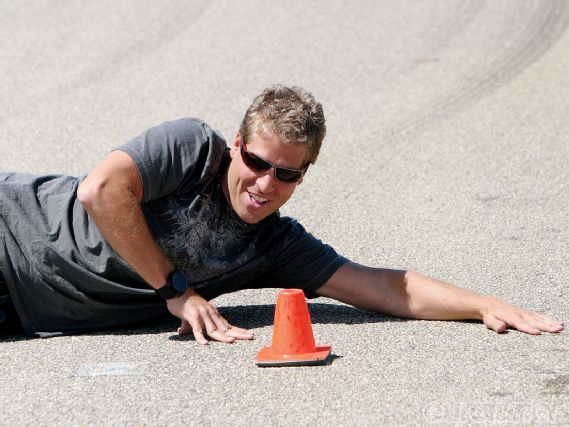 |
High-Performance Tires Buying Guide - Get A Grip!
|
High-Performance Tires Buying Guide - Get A Grip!
Understanding Tires
On the following pages we have provided some specific information about each tire in the test, and here's a brief explanation about what some of the terms mean.
Tread Depth - For the most part, the tires we tested come with 10/32" tread depth. The shallower the depth, the better dry traction it should have, although the life span may be shorter.
Tread Design - There are two designs in our group: directional and asymmetric. Directional tires have a forward-rolling direction, while asymmetric have tread blocks that must be positioned toward the outside of the vehicle. In some cases, there are directional asymmetric tires.
Tread Wear - Tread wear ratings are obtained on a government-specified course, and although the number doesn't mean much, it's useful for comparison. For example, a tire with a tread wear rating of 200 should wear twice as well as a tire with a score of 100.
Traction - This rating scores only wet braking, and the tire can achieve AA, A, B, or C, where C is the worst. The AA rating was added in 1997 when new tires began to excel in wet-braking tests. Keep in mind, the traction rating doesn't take cornering ability into consideration.
Temperature - The temperature rating is scored as A, B, or C. The tire is scored when properly inflated and the car not overloaded.
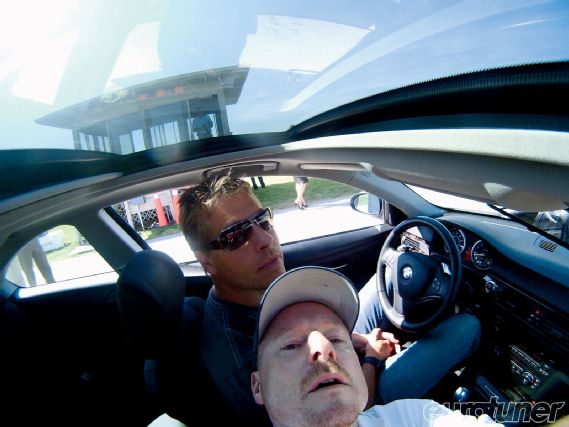 |
High-Performance Tires Buying Guide - Get A Grip!
|
High-Performance Tires Buying Guide - Get A Grip!
UTQG (Uniform Tire Quality Grade) - The UTQG comprises the tread wear, traction and temperature ratings. The UTQG is a DOT-required test all tires must undergo to be sold for street use in the USA. The UTQG is clearly printed on the sidewall of every tire. The minimum accepted for our test was a UTQG of 140.
Load Index - This is represented by a number generally between 71 and 110. It's important to note that the load index changes based on the tire's size. For the 225/45 R17 we tested, most fell between 90 and 94. A load index of 90 means the tire can support 1323 lb, whereas a rating of 94 means it can support 1477 lb. Generally, the smaller the tire, the lower the load index. A higher load rating can sometimes explain a heavier construction.
Speed Rating - This is achieved by running a tire on a metal drum at the correct load and speed for 10 minutes, then increasing the speed by 6.2mph. Most people view Z-rated tires as the best, but this is outdated. Z-rating means the tire is rated at a generic 149-plus mph, and many people thought there would be no need to rate a tire at a higher speed. However, new tires are rated at V (149mph), W (168mph) or Y (186mph).
Bridgestone
Potenza RE-11
Published Tread Depth: 9/32"
Actual Tread Depth: 9/32"
Tread Design: Asymmetric
Tread Wear: 180
Traction: A
Temperature: A
Load Index/Speed Rating: 94W
Measured weight: 25.6 lb
Contact: www.bridgestonetire.com
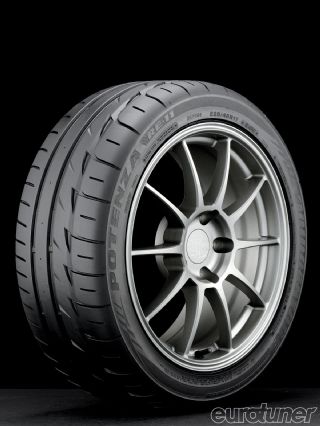 |
High-Performance Tires Buying Guide - Get A Grip!
|
High-Performance Tires Buying Guide - Get A Grip!
Dry Lap Time: 29.500sec Slalom: 4.251sec Skid Pad: 0.967g Braking from 50mph: 78.8ft
Wet Lap Time: 31.919sec Slalom: 4.476sec Skid Pad: 0.793g Braking from 50mph: 98.7ft
Driver's comments Dry These felt very similar to the [Yokohamas] but had slightly better turn-in to the apex. They created far more confidence than the other tires excluding the [Yokos], giving good grip and transitions. You could literally feel the tread blocks grabbing the road where other tires would let go. They actually made the car feel as if it had stiffer springs.
Wet The grip under braking and acceleration were better than its lateral grip. These felt average, but certainly not a bad tire, probably somewhere in the middle (7th overall in the wet). You needed to be smooth with them because you couldn't find much turn-in bite.
Continental
ExtremeContact DW
Published Tread Depth: N/A
Actual Tread Depth: 11/32"
Tread Design: Asymmetric
Tread Wear: 340
Traction: AA
Temperature: A
Load Index/Speed Rating: 91W
Measured weight: 20.8 lb
Contact: www.conti-online.com
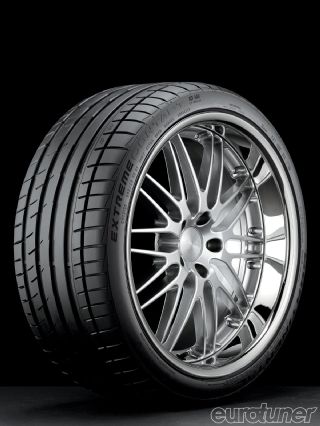 |
High-Performance Tires Buying Guide - Get A Grip!
|
High-Performance Tires Buying Guide - Get A Grip!
Dry Lap Time: 29.340sec Slalom: 4.159sec Skid Pad: 0.920g Braking from 50mph: 81.9ft
Wet Lap Time: 31.078sec Slalom: 4.352sec Skid Pad: 0.855g Braking from 50mph: 96.5ft
Driver's Comments Dry There was very good braking grip, and far more overall grip than [Michelin, Vredestein]. They felt very good in transition and gave confidence early, allowing you to push harder. But once you found the limit and thought they'd peaked, you could push again.
Wet There was a huge amount of braking grip and everything else was significantly better than [Vredestein, Pirelli, Michelin]. There was good lateral grip but braking was exceptional. You could push harder with each lap and it kept rewarding you.
Best overall Best dry lap Best wet overall Best wet lap Best wet grip
Dunlop
Direzza Sport Z1 Star Spec
Published Tread Depth: 10/32"
Actual Tread Depth: 9/32"
Tread Design: Directional
Tread Wear: 200
Traction: A
Temperature: A
Load Index/Speed Rating: 90W
Measured weight: 25.8 lb
Contact: www.dunloptires.com
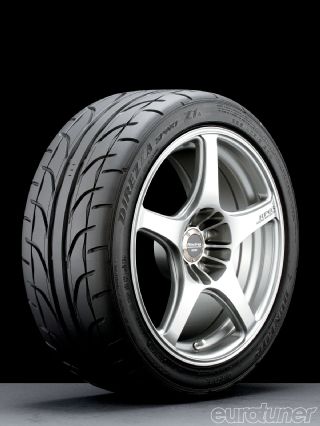 |
High-Performance Tires Buying Guide - Get A Grip!
|
High-Performance Tires Buying Guide - Get A Grip!
Dry Lap Time: 29.646sec Slalom: 4.134sec Skid Pad: 0.938g Braking from 50mph: 78.7ft
Wet Lap Time: 31.722sec Slalom: 4.464sec Skid Pad: 0.822g Braking from 50mph: 102ft
Driver's Comments Dry Above average in grip, these tires kept giving more as you pushed harder. Mid-corner and exit grip was especially high, but the entry grip was average. So going into corners they'd feel like their competitors, but coming out they felt very strong.
Wet Braking grip was better than lateral grip. However, while the initial turn-in was good, they'd get loose when you got on the power, making them hard to read. They reacted fast to the steering but lacked overall grip.
Hankook
Ventus R-s3
Published Tread Depth: 9/32"
Actual Tread Depth: 8/32"
Tread Design: Directional
Tread Wear: 140
Traction: A
Temperature: A
Load Index/Speed Rating: 94W
Measured weight: 25.0 lb
Contact: www.hankooktireusa.com
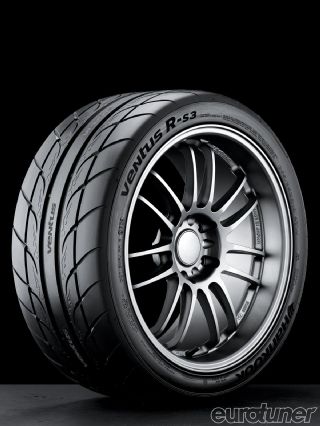 |
High-Performance Tires Buying Guide - Get A Grip!
|
High-Performance Tires Buying Guide - Get A Grip!
Dry Lap Time: 29.350sec Slalom: 4.068sec Skid Pad: 0.964g Braking from 50mph: 80.0ft
Wet Lap Time: 32.099sec Slalom: 4.525sec Skid Pad: 0.794g Braking from 50mph: 101.3ft
Driver's Comments Dry These felt like the [Pirelli], being quiet rather than squealing and had very good transitional grip. The ultimate grip gave very good feel and they were strong on the brakes, triggering the ABS very late. I liked these tires and they had more grip than most.
Wet Feeling similar to [Dunlop], they had good lateral grip but not as much braking. At the limit they would slide progressively rather than snap away. In fact, they would initially slide in the transitions then find grip.
Best In Dry Best Dry Slalom
Kumho
Ecsta XS
Published Tread Depth: 9/32"
Actual Tread Depth: 7/32"
Tread Design: Asymmetric
Tread Wear: 180
Traction: AA
Temperature: A
Load Index/Speed Rating: 91W
Measured weight: 23.0 lb
Contact: www.kumhousa.com
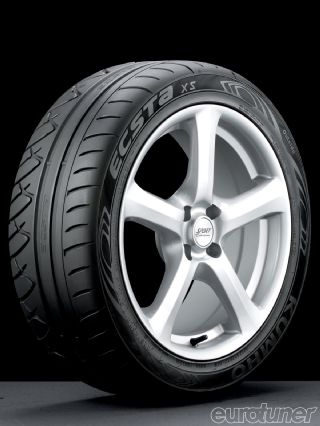 |
High-Performance Tires Buying Guide - Get A Grip!
|
High-Performance Tires Buying Guide - Get A Grip!
Dry Lap Time: 29.762sec Slalom: 4.221sec Skid Pad: 0.955g Braking from 50mph: 80.9ft
Wet Lap Time: 32.120sec Slalom: 4.627sec Skid Pad: 0.703g Braking from 50mph: 106.4ft
Driver's Comments Dry These tires felt very similar to [Yokohama and Bridgestone], except they appeared to have less grip on the exit from corners. They were almost identical to [Bridgestone] in transitional grip.
Wet There was low grip everywhere and they would slide but never seemed to gain traction, particularly in standing water. They were equally poor at turning, braking and acceleration and aren't a tire for a rookie in the rain.
Michelin
Pilot Sport 2
Published Tread Depth: 10/32"
Actual Tread Depth: 10/32"
Tread Design: Asymmetric
Tread Wear: 220
Traction: AA
Temperature: A
Load Index/Speed Rating: 91Y
Measured weight: 22.4 lb
Contact: www.michelin-us.com
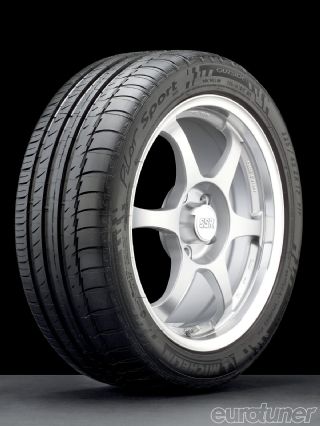 |
High-Performance Tires Buying Guide - Get A Grip!
|
High-Performance Tires Buying Guide - Get A Grip!
Dry Lap Time: 29.685sec Slalom: 4.119sec Skid Pad: 0.953g Braking from 50mph: 83.4ft
Wet Lap Time: 31.568sec Slalom: 4.332sec Skid Pad: 0.802g Braking from 50mph: 96.5ft
Driver's Comments Dry They had good turn-in and initial grip but the front end would give up quite quickly. In fact, they seemed to fade after a few laps. However, they had good grip under braking.
Wet There was consistent grip at all times, which made them an easy tire to drive because they held no surprises.
Pirelli
Pzero
Published Tread Depth: 10/32"
Actual Tread Depth: 10/32"
Tread Design: Asymmetric
Tread Wear: 220
Traction: AA
Temperature: A
Load Index/Speed Rating: 94Y
Measured weight: 21.0 lb
Contact: www.us.pirelli.com
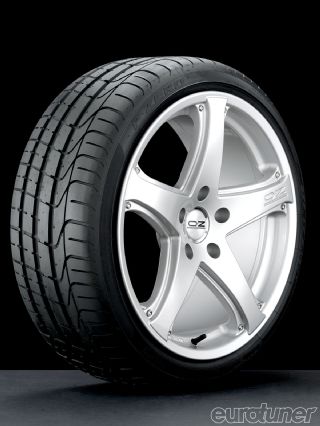 |
High-Performance Tires Buying Guide - Get A Grip!
|
High-Performance Tires Buying Guide - Get A Grip!
Dry Lap Time: 29.657sec Slalom: 4.105sec Skid Pad: 0.945g Braking from 50mph: 81.7ft
Wet Lap Time: 31.249sec Slalom: 4.304sec Skid Pad: 0.840g Braking from 50mph: 99.7ft
Driver's Comments Dry The first thing I noticed was the lack of squealing in the corners. This led me to believe they had high grip and allowed me to be aggressive on the throttle. And while they were consistent, overall they weren't as good as [Conti] in the corners.
Wet They would turn-in very well but lacked some rear-end traction, so I had to be careful getting on the throttle. Braking was good though.
Best Wet Slalom
Toyo
Proxes R1R
Published Tread Depth: 8/32"
Actual Tread Depth: 8/32"
Tread Design: Directional
Tread Wear: 140
Traction: AA
Temperature: A
Load Index/Speed Rating: 91W
Measured weight: 24.0 lb
Contact: www.toyotires.com
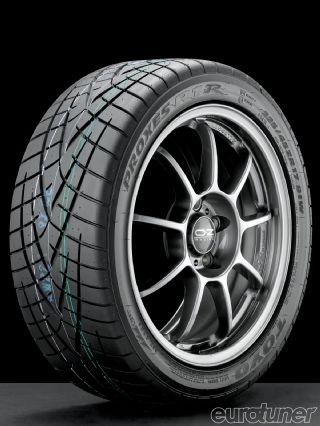 |
High-Performance Tires Buying Guide - Get A Grip!
|
High-Performance Tires Buying Guide - Get A Grip!
Dry: Lap Time: 29.548sec Slalom: 4.182sec Skid Pad: 0.925g Braking from 50mph: 77.7ft
Wet: Lap Time: 31.815sec Slalom: 4.406sec Skid Pad: 0.792g Braking from 50mph: 94.6ft
Another tire right on the edge of our UTQG limit, the R1R is for serious street and track use. It was developed from Toyo's extensive track experience with an aggressive "arrowhead" tread design that provides plenty of rubber on the road, while the grooves evacuate water. The tread blocks are also tapered to decrease irregular wear under hard use. The R1R's high-grip compound and autocross-inspired carcass allow hard cornering and acceleration on the straight-aways.
Driver's Comments Dry These tires provided plenty of confidence, inviting you to push them hard. They were especially good in transitions and bit hard under braking.
Wet Similar to [Bridgestone], they would give up in deeper water but were good in the damp. In the wet they'd slide but braked well in all conditions. Not a bad tire...
Best Dry Braking Best Wet Braking
Vredestein
Ultrac Sessanta
Published Tread Depth: N/A
Actual Tread Depth: 10/32"
Tread Design: Asymmetric
Tread Wear: 280
Traction: AA
Temperature: A
Load Index/Speed Rating: 94Y
Measured weight: 22.2 lb
Contact: www.vredestein.com
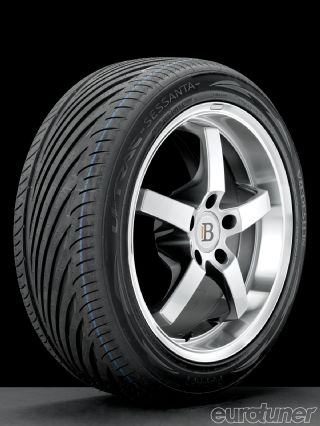 |
High-Performance Tires Buying Guide - Get A Grip!
|
High-Performance Tires Buying Guide - Get A Grip!
Dry: Lap Time: 29.915sec Slalom: 4.314sec Skid Pad: 0.912g Braking from 50mph: 85.3ft
Wet: Lap Time: 31.477sec Slalom: 4.425sec Skid Pad: 0.831g Braking from 50mph: 103.4ft
The newest UHP tire from this Dutch company, the Sessanta builds on the strengths of the Ultrac series and has been optimized for steering response and grip. Giugiaro Design gave it the distinctive appearance, while the Sessanta name is Italian and refers to the 60 years of Vredestein's existence.
Driver's Comments Dry These tires lacked grip in the transitions, where they would slide a lot and were quick to "push" on corner entry. They were consistent throughout the laps but didn't excel
Wet These slid easily and didn't like to be pushed hard. They never felt planted.
Yokohama
Advan Neova AD08
Published Tread Depth: 9/32"
Actual Tread Depth: 9/32"
Tread Design: Directional
Tread Wear: 180
Traction: AA
Temperature: A
Load Index/Speed Rating: 91W
Measured weight: 24.0 lb
Contact: www.yokohamatire.com
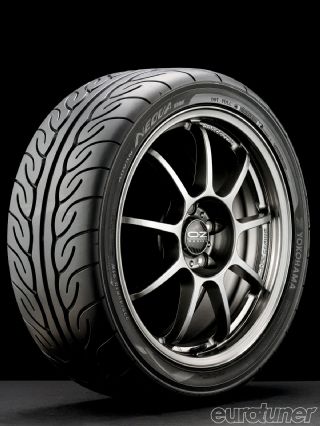 |
High-Performance Tires Buying Guide - Get A Grip!
|
High-Performance Tires Buying Guide - Get A Grip!
Dry: Lap Time: 29.531sec Slalom: 4.134sec Skid Pad: 0.974g Braking from 50mph: 80.3ft
Wet: Lap Time: 31.965sec Slalom: 4.424sec Skid Pad: 0.784g Braking from 50mph: 99.2ft
As a replacement for the highly-regarded AD07, this new summer tire combines micro-silica with Hyper Density Carbon to produce a compound for damp and dry conditions. The AD08's tread pattern features twin circumferential center ribs and wide shoulders to increase cornering stability and steering response. Three large circumferential grooves and the swirling HydroArc channels enhance wet traction, while the reinforced carcass was designed for high-speed stability and high-speed cornering. However, this is another tire not recommended for cold conditions.
Driver's Comments Dry There was more lateral grip than any other tire. They seemed stickier and were very good during turn-in, mid-corner and on the exit. The high-speed stability was very good and they were easy to drive. This was one of my favorites [along with Bridgestone].
Wet Better than [Kumho], these also wanted to slide, but less so. They were more fun because you weren't out of control. I could live with them if their dry performance compensated, but they weren't one of the best...
Best Dry Grip
Conclusions
There are several conclusions to be drawn. Firstly, there isn't a bad tire here - just some that are slightly better than others. Therefore, you should decide what you want from a tire and how much you can afford. If you live in SoCal, AZ, NV, etc and don't see rain all year, you could simply ignore the wet performance and go for the tires that perform best in the dry (and that's pretty much all of them...). However, you could narrow it down to tires that perform well in the slalom and brake hard if they are your priorities.
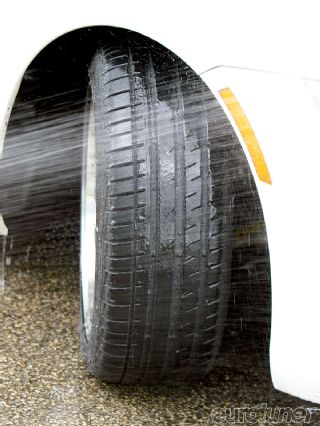 |
High-Performance Tires Buying Guide - Get A Grip!
|
High-Performance Tires Buying Guide - Get A Grip!
If you live somewhere like Seattle, you might want to concentrate on wet weather ability, where the differences were greater. To be precise, the difference between the best and worst tires in the dry was about 2% or 0.6sec on the short lap, whereas the gap increased to 9.6% or 1.4sec in the wet. This means those blessed with low rainfall could base their choice on price, because all are pretty close. However, those who regularly encounter wet roads should study the data and make a careful selection. Look closely at wet braking distances for the sake of your loved ones.
If you turn to the individual tire information you'll find specific details about lap times, stopping distances, etc to help you compare the products. You'll also find our various recommendations for specific applications, as well as comments from the driver. His views were given 'blind' - that is to say he didn't know what tires he was commenting on so are without bias.
Obviously, our test didn't consider tire wear or noise. That's because it's impossible to drive thousands of miles in the time allotted. Each tire only completes a relatively small number of timed laps and braking tests during our two days, so it's not enough to measure wear. On the previous pages we've included data such as traction rating, tread depth and tread type, since all have a bearing on wear rate.
In our third eurotuner tire test we've tried to provide the important information about grip and wet weather performance. As you can see, the difference between the 10 tires was small in the dry but slightly more substantial in the wet, making that choice more complicated. However, the overall winner and the top finishing tires would all make excellent tires for whatever you drive. Anyway, it's time for you to make some decisions. Good luck.
DRYOVERALL DRY
LAP DRY
SLALOM DRY
GRIP DRY
BRAKING
WET
OVERALL WET
LAP WET
SLALOM WET
GRIP WET
BRAKING Bridgestone 99.20 99.45 95.50 99.28 98.58 96.18 97.29 96.00 92.75 95.67 Continental 97.69 100 97.76 94.46 94.59 100 100 98.88 100 97.99 Dunlop 99.08 98.96 98.38 96.30 98.71 96.38 97.93 96.28 96.14 92.18 Hankook 100 99.97 100 98.97 97.04 95.08 96.71 94.87 92.87 92.92 Kumho 98.17 98.56 96.24 98.05 95.88 90.43 96.65 92.50 82.22 87.53 Michelin 98.00 98.82 98.75 97.84 92.66 98.16 98.42 99.35 93.80 97.99 Pirelli 98.46 98.92 99.09 97.02 94.85 98.85 99.45 100 98.25 94.61 Toyo 98.86 99.29 97.20 94.97 100 97.74 97.63 97.63 92.63 100 Vredestein 94.92 98.04 93.95 93.63 90.22 96.70 98.72 97.19 97.19 90.70 Yokohama 99.60 99.35 98.38 100 96.65 96.05 97.15 97.21 91.70 95.14
Point Scoring
The scoring system was devised to accurately reflect what happened during the test. So when you look at the individual disciplines such as lap time, slalom, etc, you'll notice the best tire scored 100% and everything else is shown as a percentage of that tire. It shows that almost every tire is within 2-3% of the winner in the dry. This drops to about 10% in the wet. However, it means that the very worst tire is only 10% less effective than the best. Therefore, you can consider other elements such as cost and application (ie, will you be doing track days, how often do you drive in the wet, etc).
The overall points scoring is based on combining all the points scored in the individual disciplines to find the best ultra-high performance tires sold in America. It also tells you there isn't really a bad performance tire sold in America, but there are those that will better suit your purposes.
As we said before, we've color-coded the types of tires tested. The max performance tires are colored red, with the extreme performance in green to help you identify which tires best suit your needs and budget.
Overall Finish Continental ExtremeContact DW 100 Pirelli P Zero 99.81 Toyo Proxes R1R 99.45 Michelin Pilot Sport PS2 99.23 Yokohama Advan Neova AD08 98.96 Dunlop Direzza Sport Z1 Star Spec 98.88 Bridgestone Potenza RE-11 98.83 Hankook Ventus R-s3 98.68 Vredestein Ultrac Sessanta 96.93 Kumho Ecsta XS 95.40Test Facts
During the tests we made:
112 test laps
Covered 37 miles
112 tire changes
1120 lug
removal/installations
560 lug torques
48 wheels used
148 50-0mph ABS brake stops
Consumed 5 pizzas
48 bottles of water
Big Thanks Woody, Matt, John, Craig and Mike from Tire Rack (www.tirerack.com), Will Turner (www.turnermotorsport.com)

